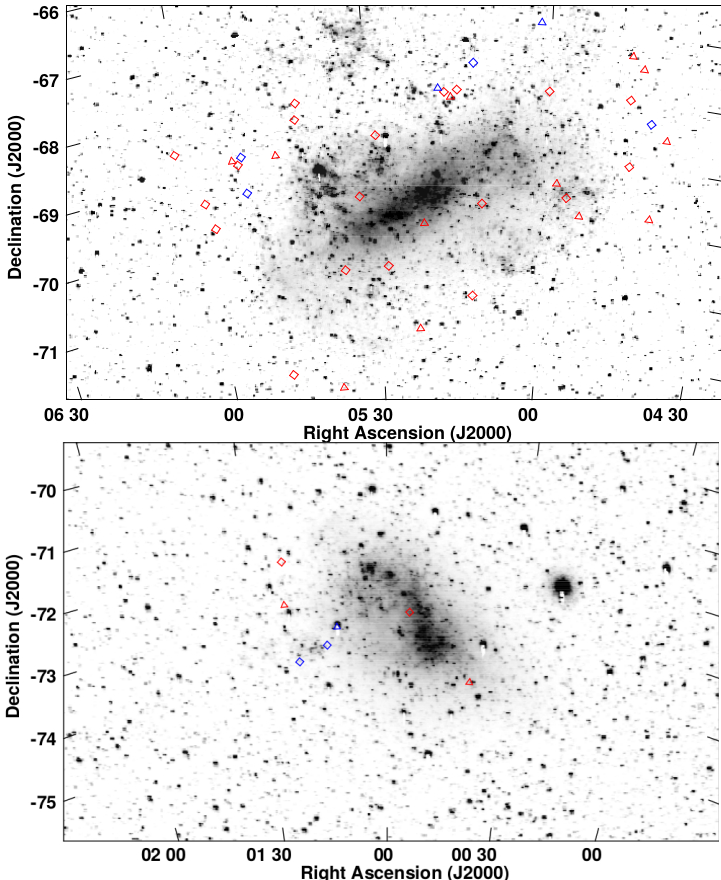Astronomy Object of the Month: 2018, November
< previous Archive next >
Blazars observed behind the Magellanic Clouds
Flat-spectrum radio quasars (FSRQs) and BL Lacertae objects (BL Lacs) constitute a class of active galactic nuclei (AGN) called blazars. Their
total radiative energy is dominated by non-thermal emission from relativistic jets launched by accretion disk - supermassive black hole system
most often located in center of massive elliptical galaxies. The FSRQs exhibit prominent emission lines in their optical spectra due to the
thermal plasma contribution, while such lines are weak or even absent in the BL Lacs.

Illustration 1: Distribution of the selected blazar candidates behind the Large (top panel) and Small (bottom panel) Magellanic Clouds. The optical positions of the FSRQ candidates are shown with red diamond symbols, while red triangular symbols denote the BL Lac candidates. Objects with polarimetric measurements are additionally marked with blue symbols. Credit: the Authors.
Identification of AGNs in dense stellar fields such as the Large and Small Magellanic Clouds (MCs) is extremely challenging, due to large densities of stars (~106 deg-2) in the interstellar medium as compared to quasars (~25 deg-2) from the background, for a limiting magnitude I < 20. Blazars behind the MCs were selected from the Magellanic Quasars Survey (MQS; Kozłowski et al. 2013) catalogue based on optical data conducted by the Optical Gravitational Lensing Experiment (OGLE), supervised by the Astronomical Observatory of the University of Warsaw.
The MQS targeted the entire Large Magellanic Cloud and 70% of the Small Magellanic Cloud. Among the 758 MQS quasars and 898 unidentified objects, a sample of 44 blazar candidates were identified, including 27 FSRQs and 17 BL Lac objects (Figure 1). All the blazar candidates were identified with respect to their radio, optical, and mid-infrared properties. The newly selected blazar candidates possess the long-term (~15 years), multi-colour (I nad V filters) photometric data from the OGLE, multi-colour mid-infrared observations, and archival radio data for at least one frequency. Moreover, nine blazar candidates have radio polarization data.
The identified blazar candidates can be used to study the physics behind the blazar variability detected in the optical and mid-infrared bands, as a tool to investigate magnetic field geometry of the LMC and SMC, and as an exemplary sample of point-like sources most likely detectable in gamma-ray range with the newly emerging Cherenkov Telescope Array.
Original publication entitled Identification of blazar candidates behind Small and Large Magellanic Clouds is accepted by Astrophysical Journal. It is the result of collaboration between the Astronomical Observatories of the Jagiellonian University and Warsaw University. (N. Żywucka, A. Goyal, M. Jamrozy, Ł. Stawarz, M. Ostrowski, S. Kozłowski, A. Udalski).
The project is part of research conducted at the Departments of High Energy Astrophysics, Radioastronomy and Space Physics and Stellar and Extragalactic Astronomy< of the Jagiellonian University’s Astronomical Observatory (OAUJ).
|
Natalia Żywucka-Hejzner Astronomical Observatory Jagiellonian University Natalia.Zywucka [at] uj.edu.pl |


